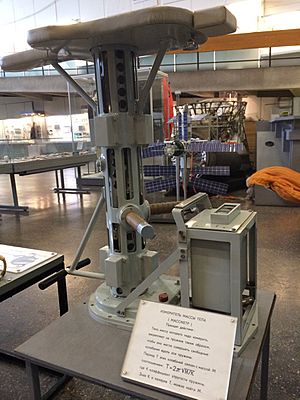Mass facts for kids
The mass of an object is a way to measure how much "stuff" is in it. It also tells us how hard it is to make an object speed up or slow down. Think of it like this: a big mountain has a lot more mass than a small rock. Mass is different from weight, which is how strongly gravity pulls on an object. For example, a large mass like Earth pulls on a smaller mass like you, keeping you from floating away. This pulling force between objects with mass is called gravity.
Units of Mass
The main unit for measuring mass in the International System of Units (which is used by most countries) is the kilogram, shown as 'kg'.
We also use smaller or larger units:
Sometimes, different fields use special units to make things easier:
- Scientists who study tiny atoms use atomic mass units because atoms are so incredibly small.
- Jewelers measure small gems and precious stones in carats. One carat is equal to 200 milligrams, or 0.2 grams.
- The masses of stars are huge! So, astronomers sometimes measure them in Solar masses, which is the mass of our Sun.
You might also hear about older units, especially in countries like the United States. These are Imperial units like the ounce or the pound. The U.S. also uses a "short ton" (2,000 pounds) and a "long ton" (2,240 pounds), which are different from the metric tonne (1,000 kg).
Mass and Speed
For a long time, people thought that the total mass of objects always stayed the same, even if they interacted or changed form. This idea, called the conservation of mass, is still a very good rule for most things we do every day.
However, a famous scientist named Albert Einstein showed that if an object moves extremely fast, its mass can actually increase. This only happens when an object moves at speeds close to the speed of light, which is incredibly fast! For example, a spaceship traveling at almost the speed of light would have more mass than when it's sitting still. But don't worry, for everyday speeds, this change in mass is so tiny that we don't even notice it.
Related pages
Images for kids
-
This ancient drawing from the Papyrus of Hunefer (around 1285 BCE) shows early balance scales. The scene depicts Anubis weighing a heart.
See also
 In Spanish: Masa para niños
In Spanish: Masa para niños







